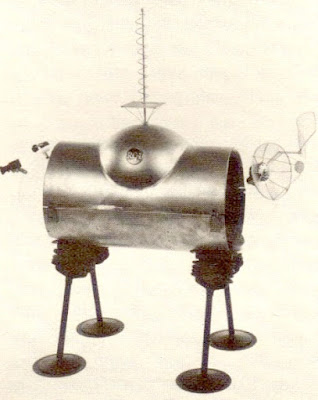In the sixties, children's interests were very strictly polarised, girls had their dolls and their fluffy animals and boys had cars and army and space. This made for very simple marketing of toys and models, as the target demographic was clear cut and easy to identify. As such, annuals and comics could be simply collated with stirring stories of war, adventure, intrigue and heroism for boys, padded out with articles about technology and sports. Odhams 'Boys World' annuals are a fine example of this style of publication, with a round up of hobbies, comic strips and informative articles for the average pre-teen boy. The comic strips are re-prints from various weeklys of the day, supplemented by text stories punctuated with illustrations, which mostly had been published earlier. The 1966 annual catches the moon race zeitgeist and prominently displays a rocket on the cover - something which was at the forefront of almost every advertising avenue at the time, as preparations were well under way for a moon landing just three years hence.
Inside is a generous double page spread showing the projected Project Apollo spacecraft, styled after the early press released images of the LEM and Saturn rockets.
Like so many early visions of the vehicle, it shows spidery legs and a simple blocky body, far removed from the angular final version. The massive crawler designed to move the rocket from the Vehicle Assembly Building to the pad is also shown, with a very simplistic Saturn V waiting for launch.Possibly the most interesting spread is the final pairing, showing a very Major Matt Mason style astronaut happily wandering the lunar surface. The last page shows something which I always looked forward to in any space books and that was a glimpse of the future and projected vehicles which would be used to ferry crews to orbiting space stations. Rather than show an imaginary shuttlecraft, Odhams have managed to procure some good imagery of various designs from Martin, Boeing, Douglas and Lockheed - clearly take from official source materials.The Martin shuttle design also appeared in a small Odhams pocket book of space, given away around the same time with orange juice. The images would probably be based on official NASA press-releases or information shown in Aviation Week or Popular Mechanics magazines, at the time.
The 1967 annual prominently features Triang Hornby train models on the cover, with a dynamic painting of a tank launching twin surface to air missiles, from the back of a gondola low loader wagon. Presumably this is a bit of product placement by Triang, as the annual has several articles about model railways and aircraft modelling, prominently featuring Triang Hornby products. Presumably the company would have bought space in the annual as a means to advertise their xmas range of products.
Triang Hornby had been well established as a major supplier and maker of HO gauge model trains for some time, but like most other toys companies at the time, they sought to capitalise on the fascination with all things space, which was dominating the headlines.
The Battlespace range were a predominantly military themed range, using earlier army style wagons, which added a more dedicated 'space' feel to the line with the Satellite Launcher wagon, which set a small propeller based satellite speeding into the air as the car went past a track based activator switch.The satellite set was a development of the Helicopter wagon from the earlier army releases, and the annual cover also features the plane launcher wagon, which carried a foam core flying plane, which kids could launch separately via a catapult.
The large red bomb on the low loader was a cap fired toy, which when thrown, would activate the explosive cap in the nose.
To bring the series firmly into the realm of space, one of the later releases was the Turbo Car, shown above in an early pre-production illustration and below in the final product. The locomotive had a spinning fan at the rear and a large 'ramming spike' on the front for a direct assault on enemy vehicles, which happened to be on the same line! A range of small military figures were included with some sets and rocket launch pads and gun emplacements were available as trackside accessories, although it was never actually made clear who the space battle was taking place with.











.gif)




























































